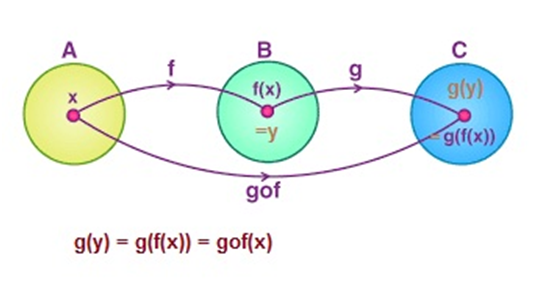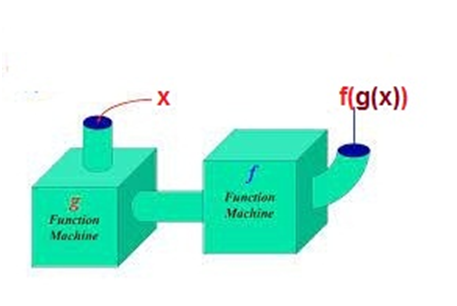- Books Name
- Mathmatics Book Based on NCERT
- Publication
- KRISHNA PUBLICATIONS
- Course
- CBSE Class 12
- Subject
- Mathmatics
Composition of Functions
Let f: A → B and g: B → C be two functions. Then the composition of f and g, denoted by gof, is defined as the function gof: A → C given by;
gof (x) = g(f (x)), ∀ x ∈ A


Example 1. Find gof and fog when f: R → R and g : R → R is defined by
(i) f(x) = 2x + 3 and g(x) = x2 + 5.
(ii) f(x) = 2x + x2 and g(x) = x3
(iii) f (x) = x2 + 8 and g(x) = 3x3 + 1
(iv) f (x) = x and g(x) = |x|
(v) f(x) = x2 + 2x − 3 and g(x) = 3x − 4
(vi) f(x) = 8x3 and g(x) = x1/3
Solution:
(i) Given, f: R → R and g: R → R
So, gof: R → R and fog: R → R
Also given that f(x) = 2x + 3 and g(x) = x2 + 5
Now, (gof) (x) = g (f (x))
= g (2x +3)
= (2x + 3)2 + 5
= 4x2+ 9 + 12x +5
=4x2+ 12x + 14
Now, (fog) (x) = f (g (x))
= f (x2 + 5)
= 2 (x2 + 5) +3
= 2 x2+ 10 + 3
= 2x2 + 13
(ii) Given, f: R → R and g: R → R
so, gof: R → R and fog: R → R
f(x) = 2x + x2 and g(x) = x3
(gof) (x)= g (f (x))
= g (2x+x2)
= (2x+x2)3
Now, (fog) (x) = f (g (x))
= f (x3)
= 2 (x3) + (x3)2
= 2x3 + x6
(iii) Given, f: R → R and g: R → R
So, gof: R → R and fog: R → R
f(x) = x2 + 8 and g(x) = 3x3 + 1
(gof) (x) = g (f (x))
= g (x2 + 8)
= 3 (x2+8)3 + 1
Now, (fog) (x) = f (g (x))
= f (3x3 + 1)
= (3x3+1)2 + 8
= 9x6 + 6x3 + 1 + 8
= 9x6 + 6x3 + 9
(iv) Given, f: R → R and g: R → R
So, gof: R → R and fog: R → R
f(x) = x and g(x) = |x|
(gof) (x) = g (f (x))
= g (x)
= |x|
Now (fog) (x) = f (g (x))
= f (|x|)
= |x|
(v) Given, f: R → R and g: R → R
So, gof: R → R and fog: R → R
f(x) = x2 + 2x − 3 and g(x) = 3x − 4
(gof) (x) = g (f(x))
= g (x2 + 2x − 3)
= 3 (x2 + 2x − 3) − 4
= 3x2 + 6x − 9 − 4
= 3x2 + 6x − 13
Now, (fog) (x) = f (g (x))
= f (3x − 4)
= (3x − 4)2 + 2 (3x − 4) −3
= 9x2 + 16 − 24x + 6x – 8 − 3
= 9x2 − 18x + 5
(vi) Given, f: R → R and g: R → R
So, gof: R → R and fog: R → R
f(x) = 8x3 and g(x) = x1/3
(gof) (x) = g (f (x))
= g (8x3)
= (8x3)1/3
= [(2x)3]1/3
= 2x
Now, (fog) (x) = f (g (x))
= f (x1/3)
= 8 (x1/3)3
= 8x
Example 2. Let f = {(3, 1), (9, 3), (12, 4)} and g = {(1, 3), (3, 3) (4, 9) (5, 9)}. Show that gof and fog are both defined. Also, find fog and gof.
Solution:
Given f = {(3, 1), (9, 3), (12, 4)} and g = {(1, 3), (3, 3) (4, 9) (5, 9)}
f : {3, 9, 12} → {1, 3, 4} and g : {1, 3, 4, 5} → {3, 9}
Co-domain of f is a subset of the domain of g.
So, gof exists and gof: {3, 9, 12} → {3, 9}
(gof) (3) = g (f (3)) = g (1) = 3
(gof) (9) = g (f (9)) = g (3) = 3
(gof) (12) = g (f (12)) = g (4) = 9
⇒ gof = {(3, 3), (9, 3), (12, 9)}
Co-domain of g is a subset of the domain of f.
So, fog exists and fog: {1, 3, 4, 5} → {3, 9, 12}
(fog) (1) = f (g (1)) = f (3) = 1
(fog) (3) = f (g (3)) = f (3) = 1
(fog) (4) = f (g (4)) = f (9) = 3
(fog) (5) = f (g (5)) = f (9) = 3
⇒ fog = {(1, 1), (3, 1), (4, 3), (5, 3)}
Example 3. Let f = {(1, −1), (4, −2), (9, −3), (16, 4)} and g = {(−1, −2), (−2, −4), (−3, −6), (4, 8)}. Show that gof is defined while fog is not defined. Also, find gof.
Solution:
Given f = {(1, −1), (4, −2), (9, −3), (16, 4)} and g = {(−1, −2), (−2, −4), (−3, −6), (4, 8)}
f: {1, 4, 9, 16} → {-1, -2, -3, 4} and g: {-1, -2, -3, 4} → {-2, -4, -6, 8}
Co-domain of f = domain of g
So, gof exists and gof: {1, 4, 9, 16} → {-2, -4, -6, 8}
(gof) (1) = g (f (1)) = g (−1) = −2
(gof) (4) = g (f (4)) = g (−2) = −4
(gof) (9) = g (f (9)) = g (−3) = −6
(gof) (16) = g (f (16)) = g (4) = 8
So, gof = {(1, −2), (4, −4), (9, −6), (16, 8)}
But the co-domain of g is not same as the domain of f.
So, fog does not exist.
Example 4:. If f(x) = |x|, prove that fof = f.
Solution:
Given f(x) = |x|,
Now we have to prove that fof = f.
Consider (fof) (x) = f (f (x))
= f (|x|)
= ||x||
= |x|
= f (x)
So,
(fof) (x) = f (x), ∀x ∈ R
Hence, fof = f.

 KRISHNA PUBLICATIONS
KRISHNA PUBLICATIONS
